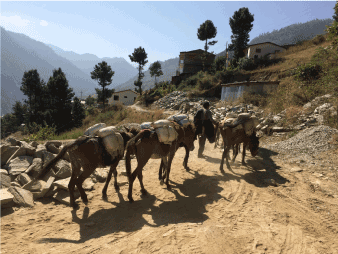There is a global trend of non-staying trained cardiologists in remote areas resulting in less opportunity of pediatric heart care. Common symptoms and signs of heart disease in children, acronym as ‘ABCDEFGHIJO’ helps to identify heart disease early in such areas leading to appropriate therapeutic option with a less economic burden in an appropriate center by a qualified physician.
cardiologist, children, congenital, heart disease, remote area
Despite modern technology and economic development, health care in remote rural areas is a far cry. Nearly one third of the global population is not connected by motorable roads. The Rural Access Index [RAI] measures the proportion of people who have access to an all-season road within an approximate walking distance of 2 kilometers (km) [1]. There is a common understanding that longer the distance from a motorable road harder to expand modern economic and social activities such as health facilities. Moreover, there is a global trend of non-staying trained physicians, cardiologists and health personnel in remote areas leading to increased morbidity and mortality in the population. Since motorable connectivity is the pillar of expansion of health facilities, lack of such facilities is still a reality in many parts of the globe including Nepal [2] (Figure 1).

Figure 1. Donkeys carrying goods in Mugu district of Karnali zone, far-west remote district of Nepal (Photograph by Dr. NB Basnet, Oct 19, 2017 AD).
In most remote areas there are no health facilities or even if it is present there is lack of clinicians or trained health personnel who can understand the meaning and use of stethoscope, oxymetry, echocardiography to recognize heart disease in neonates, infants, children and adolescents. Neither the patients are able to visit nearby city clinics or hospitals with such facilities. Echocardiography is further uphill tests for parents, patients and health professionals. Therefore, clinical recognition of heart disease in such places is a blessing for families and communities living in remote areas. Though tremendous development of expensive diagnostic and interventional methodologies in pediatric cardiology has occurred till recent time clinical and epidemiological knowledge, skills still have vital roles in identifying heart diseases in children thus striving to decrease morbidity and mortality. A careful interview/questionnaire accompanied by basic clinical examination can reveal many congenital and acquired heart diseases in children. Even questioning about symptoms of heart disease to the parents, birth attendants, carers, patients may be very useful to recognize the heart disease during adapting and growing period of life such as infancy, childhood and adolescence. Thus, it is the focus of this communication.
The purpose of this communication is to educate/inform the commonest symptoms and signs of heart disease in children to the health personnel, parents, care givers in simplest possible means so that early recognition, finding appropriate institution and or physician is possible in the least cumbersome manner mainly in areas with low RAI.
Careful listening and meticulous observation of the symptoms as well as visible signs of heart disease can be useful to recognize congenital and acquired heart disease early in childhood that will provide tremendous help in the early management of the heart disease of the children, economy of the family and utilization of national heart health resources [3,4]. The pediatricians, primary care physicians, paramedicals, traditional birth attendants, women volunteers, nursery instructors and primary school teachers can be trained to identify heart disease in early childhood.
Many empirical observations, epidemiological studies, clinical case studies, clinical research showed that a useful, meticulous observation of the following symptoms and signs were extremely helpful in early recognition of heart disease in children. This author created a calendar of a certain year with basic information on how to recognize heart disease in children and distributed it to parents. Some parents visited the clinic again to further confirm the disease and almost all such cases were diagnosed having heart disease following confirmation with clinico-investigative parameters including echocardiography performed in a central referral cardiac hospital. The common symptoms and signs of heart diseases in children have been summarized in the acronym ABCDEFGHIJO.
- Activity: Less active, less alert, easy fatigability, exercise intolerance
- Breathing: fast, difficult, shortness of breath
- Color: bluish discoloration of tongue, lips, fingers; pale skin
- Deformity: bulged chest, deformed body organs, congenital anomalies
- Edema: swelling of face, limbs, body, abdomen
- Feeding: difficulty in sucking, poor feeding, tires easily
- Growth: delayed growth and development
- History of viral infection, diabetes, smoking and intake of drugs, alcohol during pregnancy
- Infection: recurrent respiratory infections
- Joint: pain, swelling
- Others: excessive sweating, visible pulsation on chest and neck, palpitation, syncope, faintness, seizure, restlessness, irritability, squatting posture, cold extremities, decreased urine, bleeding from nose, obesity, prematurity, malposition, clubbing
[Heart disease may present with any one or several of the above symptoms]
This simple symptomatology will not only help to identify heart disease early, it also provides information of heart health education in remote areas leading to appropriate therapeutic option with a less economic burden in an appropriate center by a qualified physician.
- Measuring Rural Access: Using New Technologies (2016) Transport & ICT Global Practice, The World Bank Group, Washington DC 20433 [Internet: http://documents.worldbank.org/curated/en/367391472117815229/pdf/107996-REVISED-PUBLIC-MeasuringRuralAccessweb.pdf].
- Basnet NB, Banstola D (2017) An observation report of Karnali Academy of Health Sciences (KAHS). Oct 16-21, 2017, Kathmandu, Nepal.
- Kumar P (2016) Universal Pulse Oximetry Screening for Early Detection of Critical Congenital Heart Disease. Clin Med Insights Pediatr 10: 35-41.
- Bertoletti J, Marx GC, Hattge Jr SP, Pellanda LC (2014) Quality of life and congenital heart disease in childhood and adolescence. Arg Bras Cardiol 102: 192-198.
2021 Copyright OAT. All rights reserv

